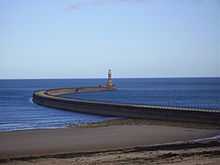Roker
| Roker | |
 Roker | |
| Population | 4,600 |
|---|---|
| OS grid reference | NZ405595 |
| Metropolitan borough | City of Sunderland |
| Metropolitan county | Tyne and Wear |
| Region | North East |
| Country | England |
| Sovereign state | United Kingdom |
| Post town | SUNDERLAND |
| Postcode district | SR6 |
| Dialling code | 0191 |
| Police | Northumbria |
| Fire | Tyne and Wear |
| Ambulance | North East |
| EU Parliament | North East England |
| UK Parliament | Sunderland Central |
| |
Roker (/ˈroʊkər/, local /ˈrɔːkər/) is a tourist resort and affluent area of Sunderland, North East England, bounded on the south by the River Wear and Monkwearmouth, on the east by the North Sea, to the west by Fulwell and on the north by Seaburn. It is administered as part of the City of Sunderland.
The majority of the houses in Roker are terraced or semi-detached. Further west, to the part bordering Fulwell, are cul-de-sacs with semi-detached bungalows, these being owned mainly by members of Roker's sizeable elderly population. Roker was known worldwide for being home to Roker Park, home of Sunderland A.F.C. for ninety-nine years until 1997.
In addition to Seaburn seafront, the coast at Roker seafront plays host to Sunderland International Airshow, the biggest free airshow in Europe, which takes place each year, usually over the last weekend in July.
On the site of Sunderland AFC's former stadium is a small housing estate, its street names all being references to the football club (Clockstand Close, Goalmouth Close, etc.). The streets in between Roker Baths Road and Roker Avenue are all named after members of William Ewart Gladstone's cabinet (Gladstone, Hartington, Forster, Bright, Stansfield, and so on). On Roker Terrace (Roker's main street) are exclusive apartments and hotels which overlook the seafront.
History
The story of Roker begins in 1587, when the Abbs family were granted land on the north side of the River Wear on the condition that they provided six soldiers to defend the mouth of the river. Fast forward to 1840, when Roker Terrace was built upon the cliff tops, along with Monkwearmouth baths and Roker Park soon after. The pier and lower promenade were built six years later. In the early 20th century it became a hugely popular resort for locals and tourists alike, and in 1928 it was taken over by the Borough of Sunderland, along with Fulwell and Seaburn.
Landmarks
St Andrew's Church (1905-7) is recognised as one of the finest churches of the first half of the twentieth century and the masterpiece of Edward Schroeder Prior.

One well-known landmark of sorts in Roker is the Bungalow Cafe, which is an old-fashioned cafe in a tiny bungalow on the upper promenade. Also famous is the signpost next to the cafe, marked: "To Beach" (pointing towards the beach), "To Village" (pointing into Roker), "To Bungalow" (pointing to the cafe), and "To Germany" (pointing out to sea).
Other landmarks are the statue of Bede's cross on the cliff top near Roker Park and St. Peter's Church Monkwearmouth[1] near Roker. The cross recognises the work of the Venerable Bede, who worked in the North-East all his life at the twin monasteries of Wearmouth and Jarrow. There is bid for the twin monasteries to gain World Heritage Site status.
Demographics
The population of Roker is approximately 4,600. Since the redevelopment of former brownfield areas of heavy industry into affluent riverside housing areas, and the founding of the St Peters Campus of the University of Sunderland to the immediate south of the area, Roker has undergone rapid demographic change. The first of these two changes brought a large influx of professional and managerial workers into the areas now known as St Peters Riverside and North Haven. The arrival of the university campus has seen a large number of the larger houses in the vicinity of Roker Avenue being converted into flats and student residences. The pursuant studentification has brought a substantial Chinese community into the area for the first time, along with a variety of other nationalities
Along with the district of Monkwearmouth, Roker forms the St Peters electoral ward on Sunderland City Council, which is a division of the Sunderland Central parliamentary seat. Previously a reliable Labour ward, St Peters is now a marginal ward, with the Conservatives taking two seats in 2004 and a third in 2006. However Labour won each seat back in 2010, 2011 and 2012, although with reduced majorities, with Labour Councillor Stephen Bonallie's majority of 74 being the smallest in Sunderland.
| Wikimedia Commons has media related to Roker, Sunderland. |
External links
- BBC Wear - Take a tour of Roker Beach
- BBC Wear - Pictures: Walk from Roker to Seaburn
- 360° view of the Roker seafront
- St Peter's Church, Monkwearmouth
| ||||||||